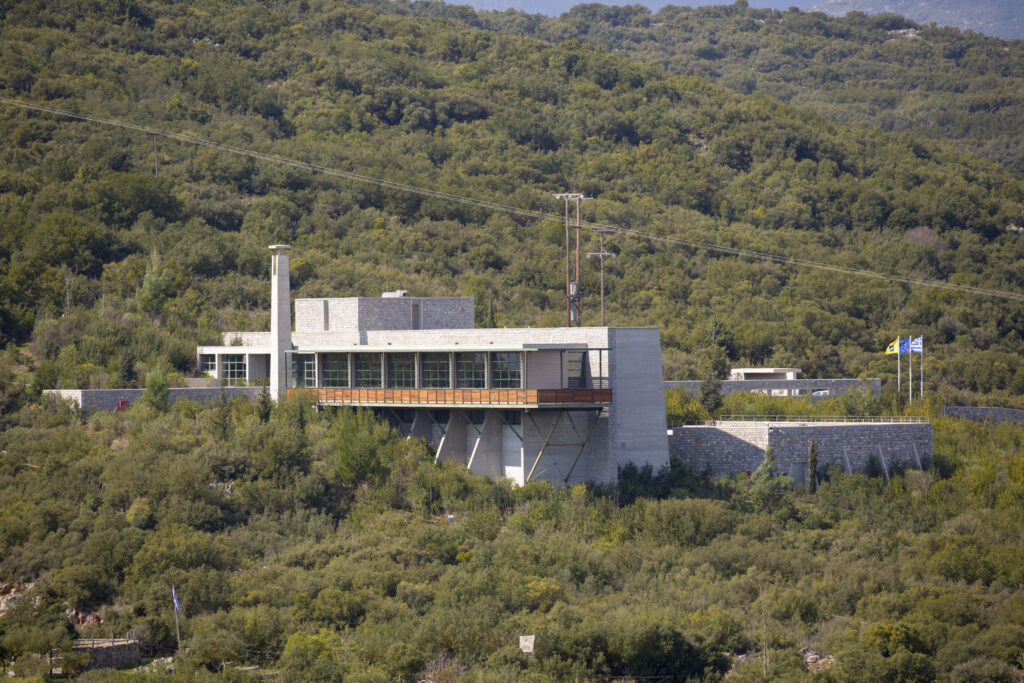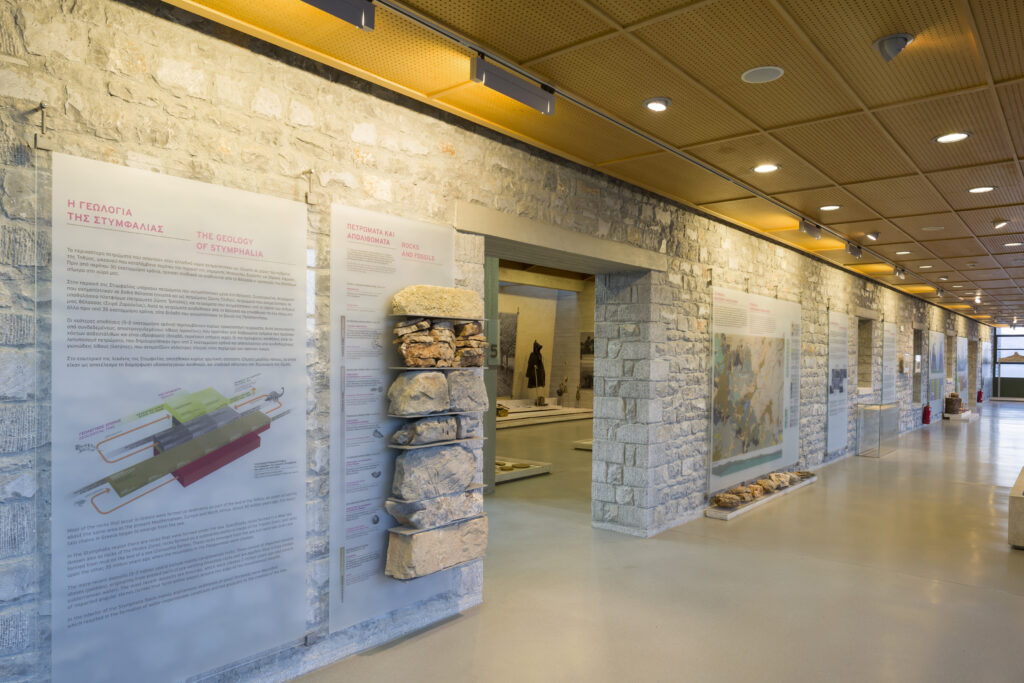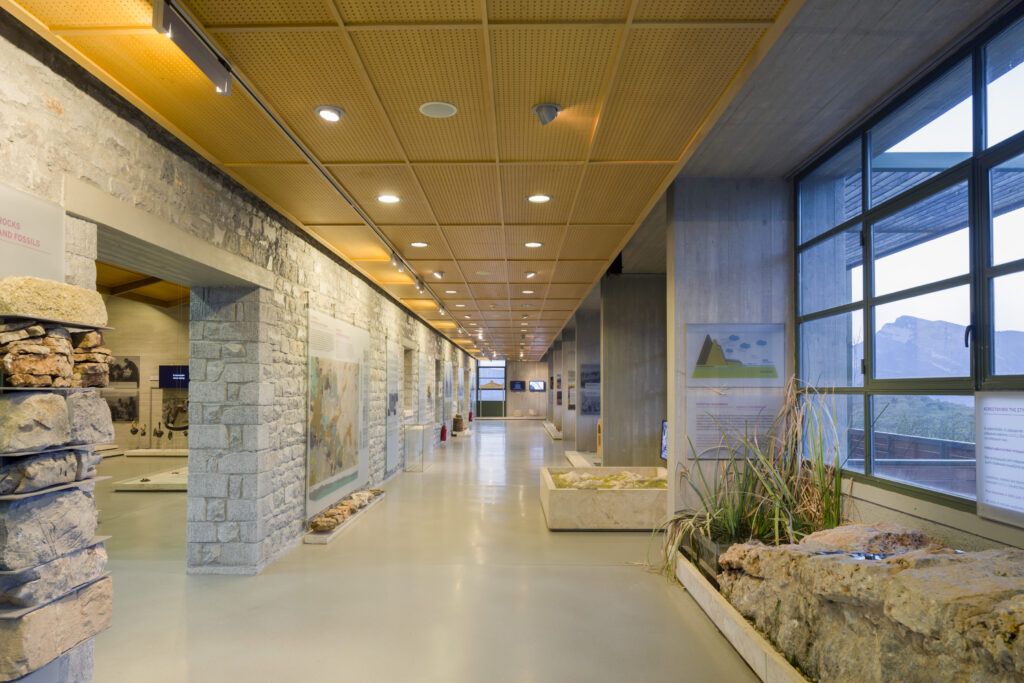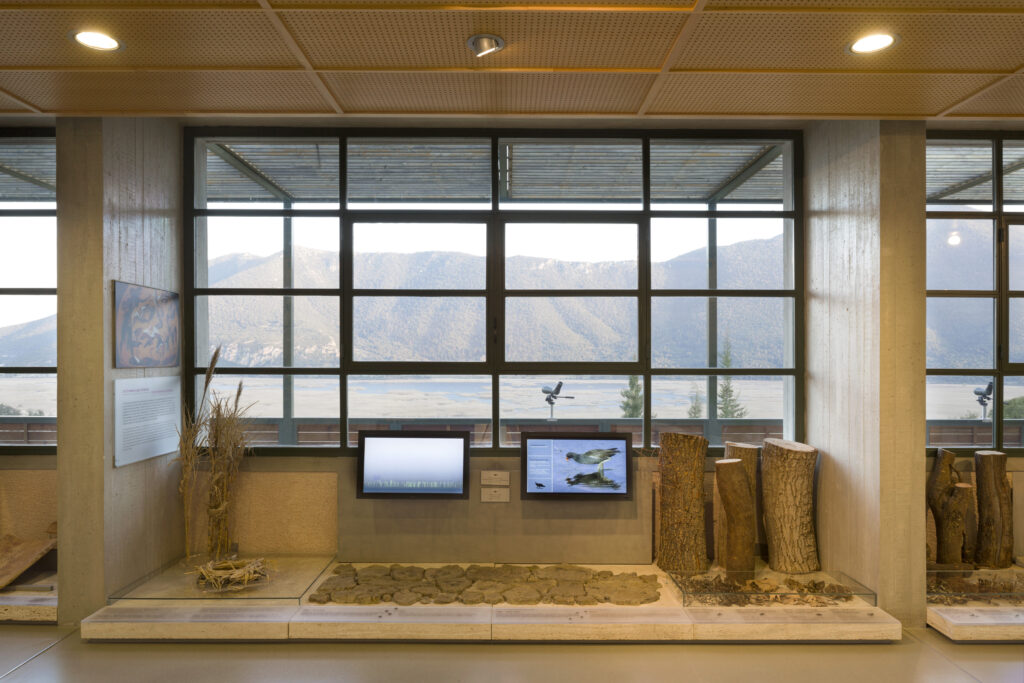The Environment Museum in Stymphalia is more than just a mere space of display; it serves as a gateway to the entire area’s unique mix of rich cultural heritage, historical and mythological significance and is framed by rare natural beauty. As promised in our article Off the beaten track in Northern Peloponnese, today we will explore this hidden gem and its surroundings.
To reach the museum from the south, we wind our way through breathtaking serpentine roads high in the mountainous regions of Corinthia. We are now eager to share our experiences from this captivating destination.

Stymphalia: where myth meets reality
Lake Stymphalia is situated on a high plateau between Kyllini (Ziria) and Oligyrtos mountains, with peaks over 6500 feet high. The lake is the Balkan Peninsula’s southernmost mountain wetland and presents a fantastic sight, especially in spring when the surrounding landscape explodes in vibrant hues.
The lake’s surface mirrors the sky and the surrounding mountains, while reeds and other dense vegetation dominate the shores. Sometimes veils of mist drift over the water, creating an enigmatic atmosphere, making it easy to understand why this place has such a prominent role in Greek mythology.

According to legend, Lake Stymphalia was the site of Hercules’ sixth labor, where he confronted the man-eating Stymphalian birds. The hero used bronze rattles, given by the goddess Athena, to drive the birds out of their hiding places in the dense vegetation and then defeat them with his arrows.
We’ll return to this legend in our series on Greek gods and mythology. Standing by the lake’s edge, it’s not hard to picture this epic battle unfolding across the misty waters.
Beyond its mythological significance, Lake Stymphalia is an important ecological habitat. It’s home to many birds, including the rare ferruginous duck (Aythya nyroca), a medium-sized duck known for its characteristic white eyes and ability to hide in the reeds. The lake also hosts endemic fish species such as Pelasgus stymphalicus, locally known as “Ντάσκα/dáska”. Growing up to 12 cm long, this small carp fish has adapted to survive by burying itself in the mud during dry periods.
Both these species are threatened, mainly due to loss of their habitats, pollution, and fishing or hunting. The area’s ecological importance and need for protection are recognized through Lake Stymfalia’s inclusion in the European network of protected areas, NATURA 2000.
As we walked around the lake, the stillness was broken only by birdsong, the whisper of the wind, and the soft lapping of water. The area offers many activities for visitors, including hiking on marked trails that pass historical sites, such as the ruins of the ancient town of Stymphalos. Birdwatching is particularly popular, and enthusiasts can see a variety of species including ducks, grebes, herons, and raptors. The European Euro Birdwatch Day has been held at Stymfalia several times.
The Environment Museum: a time travel in the ecosystem
Complementing the lake’s natural beauty is the Environment Museum of Stymphalia. As we approached the museum, we were immediately struck by its modern architecture. The building, skillfully constructed with concrete, stone, and wood, blends seamlessly into the surrounding landscape. Its glass facade offers a panoramic view of the lake and the forested mountain slopes beyond, creating a fantastic visual connection between the indoor exhibits and the living environment outside.

The Environment Museum opened in 2010 as part of The Piraeus Bank Group Cultural Foundation – PIOP’s museum network, in collaboration with the EU and the Greek state. The network consists of seven different themed museums spread across Greece. Read more about other museums in the network here >>
We have previously covered the PIOPS museum network in our article on the silk town of Soufli:
A fascinating geology
The Environment Museum is divided into two main sections. The first focuses on the unique environment of the Stymfalia basin. Here we gained access to detailed information about the region’s fascinating geology, its status as an important wetland, and its rich biodiversity. The exhibits in this section excellently illustrate how land, water, and local flora and fauna have interacted over millennia.


What we found most striking was the smaller permanent exhibition Cross-section Through the Lake. This innovative display brings the lake’s ecosystem indoors, allowing visitors to observe local plants and fish up close. It’s a brilliant way to connect the inside of the museum with the living world outside its walls.

Human presence since time immemorial

Another section of the museum explores how humans have interacted with this environment throughout history. From the time of the ancient town of Stymphalos to today, people have found ways to coexist with nature in this unique landscape. The exhibits in this section focus on traditional occupations such as agriculture, fishing, and beekeeping – all shaped by the specific conditions of the Stymphalia basin.

The museum uses various modern means of expression and audiovisual tools to enhance the visitor’s experience. These multimedia elements elevate the experience without overshadowing the central message about the delicate balance between human activity and environmental conservation.

A harmonious blend of nature and culture
The museum terrace offers a great view of Lake Stymphalia, surrounded by the region’s majestic mountains and dense vegetation.

The museum gives visitors insight into the region’s ecosystem and a profound understanding of the relationship between humans and nature.
The permanent exhibitions offer an in-depth understanding of how the landscape and its biodiversity have been shaped by the interplay between nature and humans over centuries.
For travelers in northern Peloponnese, Lake Stymfalia and its Environment Museum offer an unexpected gem off the usual tourist trails. Here, myth and reality blend in a landscape that inspires and educates.
As we left the place, we felt our heads full of images from the enchanting landscape and our hearts filled with respect for the delicate balance between humans and nature that has characterized this place for millennia. Stymfalia is more than just a destination – it’s a reminder of the timeless connection between our cultural heritage and the nature that shaped it.

You can download the Environment Museum’s pdf guide here>>
Materials and photos courtesy of the: Pireus Bank Group Cultural Foundation
Sources: Wikipedia, PIOP
